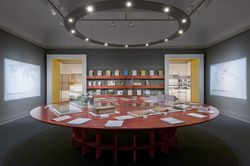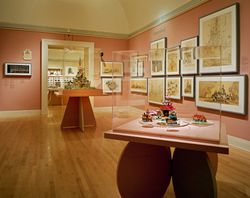Lessons from Bernard Rudofsky is the first retrospective to examine the life and work of the controversial architect, designer, and critic whose groundbreaking buildings, exhibitions, and fashion designs challenged the Western world’s perceptions of comfort and culture. The exhibition highlights the diverse contributions of a unique and underappreciated pioneer of(...)
Main galleries
4 July 2007 to 30 September 2007
Lessons from Bernard Rudofsky
Actions:
Description:
Lessons from Bernard Rudofsky is the first retrospective to examine the life and work of the controversial architect, designer, and critic whose groundbreaking buildings, exhibitions, and fashion designs challenged the Western world’s perceptions of comfort and culture. The exhibition highlights the diverse contributions of a unique and underappreciated pioneer of(...)
Main galleries
1973: Sorry, Out of Gas
1973: Sorry, Out of Gas captures the architectural innovation spurred by the 1973 oil crisis, when the value of oil increased exponentially and triggered economic, political, and social upheaval across the world. Featuring over 350 objects including architectural drawings, photographs, books and pamphlets, archival television footage, and historical artefacts, it maps the(...)
7 November 2007 to 20 April 2008
1973: Sorry, Out of Gas
Actions:
Description:
1973: Sorry, Out of Gas captures the architectural innovation spurred by the 1973 oil crisis, when the value of oil increased exponentially and triggered economic, political, and social upheaval across the world. Featuring over 350 objects including architectural drawings, photographs, books and pamphlets, archival television footage, and historical artefacts, it maps the(...)
The exhibition addresses a central and timely aspect of the work of Carlo Scarpa: its distinctive approach to contending with the layers of history that mark the fabric of a city and a building. In addressing Scarpa’s ability to weave new work into, and often out of, the disparate fragments of the old, Carlo Scarpa, Architect: Intervening with History begins to unravel(...)
Main galleries
26 May 1999 to 31 October 1999
Carlo Scarpa, Architect: Intervening with History
Actions:
Description:
The exhibition addresses a central and timely aspect of the work of Carlo Scarpa: its distinctive approach to contending with the layers of history that mark the fabric of a city and a building. In addressing Scarpa’s ability to weave new work into, and often out of, the disparate fragments of the old, Carlo Scarpa, Architect: Intervening with History begins to unravel(...)
Main galleries
Just as Andrea Palladio’s Villa Rotonda helped to define for future generations the architecture of the Renaissance in Italy, so Chiswick is the locus classicus of the Palladian Revival of the eighteenth century. This exhibition follows a major architect’s thinking as he worked from source to design, from design to representation, in the making of a building which, as the(...)
Main galleries
19 July 1994 to 25 September 1994
The Palladian Revival: Lord Burlington, His Villa and Garden at Chiswick
Actions:
Description:
Just as Andrea Palladio’s Villa Rotonda helped to define for future generations the architecture of the Renaissance in Italy, so Chiswick is the locus classicus of the Palladian Revival of the eighteenth century. This exhibition follows a major architect’s thinking as he worked from source to design, from design to representation, in the making of a building which, as the(...)
Main galleries
Empire
The exhibition presents Empire, a visual essay by American artist John Gossage on the relationship between architecture and power. Gossage’s photographs of government buildings and monuments in Washington, D.C. are juxtaposed with images of Egypt taken by German chemist Hermann Vogel in 1868, exposing the parallel actions of governments, over a century apart, in(...)
Octagonal gallery
8 December 2005 to 12 March 2006
Empire
Actions:
Description:
The exhibition presents Empire, a visual essay by American artist John Gossage on the relationship between architecture and power. Gossage’s photographs of government buildings and monuments in Washington, D.C. are juxtaposed with images of Egypt taken by German chemist Hermann Vogel in 1868, exposing the parallel actions of governments, over a century apart, in(...)
Octagonal gallery
Meditations on Piero presents contemporary sculptures by British/Canadian artist Geoffrey Smedley alongside over thirty rare books from the fifteenth to the eighteenth centuries. The sculptures draw their inspiration from a series of drawings of the human head by the great Italian Renaissance artist Piero della Francesca. The exhibition relates these drawings and(...)
Octagonal gallery
2 May 2001 to 16 September 2001
Meditations on Piero
Actions:
Description:
Meditations on Piero presents contemporary sculptures by British/Canadian artist Geoffrey Smedley alongside over thirty rare books from the fifteenth to the eighteenth centuries. The sculptures draw their inspiration from a series of drawings of the human head by the great Italian Renaissance artist Piero della Francesca. The exhibition relates these drawings and(...)
Octagonal gallery
The beginning of the 1950s was a moment of global upheaval. From India to Morocco, from Guatemala to Indochina, the process of decolonization gained momentum and the Cold War began. Architects working or acting as experts in the non-Western areas of the globe could no longer plan as if sites were terrains vague and people were mute subjects. The end of colonial(...)
Main galleries Keyword(s):
Casablanca, Chandigarh, Le Corbusier, Jeanneret, Morocco, Punjab, India, Morocco, modernism, Africa, Takashi Homma, Yto Barrada
26 November 2013 to 20 April 2014
How architects, experts, politicians, international agencies and citizens negotiate modern planning: Casablanca Chandigarh
Actions:
Description:
The beginning of the 1950s was a moment of global upheaval. From India to Morocco, from Guatemala to Indochina, the process of decolonization gained momentum and the Cold War began. Architects working or acting as experts in the non-Western areas of the globe could no longer plan as if sites were terrains vague and people were mute subjects. The end of colonial(...)
Main galleries Keyword(s):
Casablanca, Chandigarh, Le Corbusier, Jeanneret, Morocco, Punjab, India, Morocco, modernism, Africa, Takashi Homma, Yto Barrada
Disneyland, with its far-flung colonies in Florida, Japan, and France, is a key symbol of contemporary American culture that has been both celebrated and attacked as the ultimate embodiment of consumer society, of simulation and pastiche, of the blurring of distinctions between reality and mass-media imagery. The Architecture of Reassurance: Designing the Disney Theme(...)
Main galleries
17 June 1997 to 28 September 1997
The Architecture of Reassurance: Designing the Disney Theme Parks
Actions:
Description:
Disneyland, with its far-flung colonies in Florida, Japan, and France, is a key symbol of contemporary American culture that has been both celebrated and attacked as the ultimate embodiment of consumer society, of simulation and pastiche, of the blurring of distinctions between reality and mass-media imagery. The Architecture of Reassurance: Designing the Disney Theme(...)
Main galleries
The exhibition presents a work by American artist Lewis Baltz that provokes critical thought on the relationships between architecture, landscape, and photography. The New Industrial Parks is part of a monographic series developed in the 1970s (The Tract Houses, Maryland, Nevada and Park City) that deals with wide-ranging cultural and philosophical questions about(...)
Octagonal gallery
18 April 2002 to 29 September 2002
Lewis Baltz: The New Industrial Parks Near Irvine, California
Actions:
Description:
The exhibition presents a work by American artist Lewis Baltz that provokes critical thought on the relationships between architecture, landscape, and photography. The New Industrial Parks is part of a monographic series developed in the 1970s (The Tract Houses, Maryland, Nevada and Park City) that deals with wide-ranging cultural and philosophical questions about(...)
Octagonal gallery
Portuguese architect Álvaro Siza travelled to Peru in 1995 with his usual baggage: only a few changes of clothes, some books of poetry, and a single sketchbook. This was the toolkit he used to interpret the voyage and integrate it into his architecture. More than half a century earlier, Peruvian photographer Martín Chambi had taken his famous series of portraits of the(...)
Octagonal gallery
26 January 2012 to 29 April 2012
Alturas de Machu Picchu: Martín Chambi – Álvaro Siza at work
Actions:
Description:
Portuguese architect Álvaro Siza travelled to Peru in 1995 with his usual baggage: only a few changes of clothes, some books of poetry, and a single sketchbook. This was the toolkit he used to interpret the voyage and integrate it into his architecture. More than half a century earlier, Peruvian photographer Martín Chambi had taken his famous series of portraits of the(...)
Octagonal gallery









